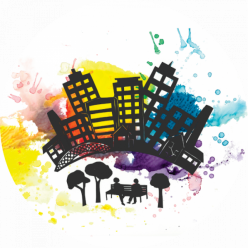Our in conversation with … series of posts introduces readers to the people behind the Transforming Stories, Driving Change project. These are the artists, researchers, and community participants who desire Transforming Stories to make a substantive contribution to civic engagement in the city of Hamilton.
Melanie Skene is a visual artist, puppeteer, and production coordinator on Transforming Stories, Driving Change.
This project is adding different layers of voices to our vision of Hamilton. Hamilton is changing. There are people talking about change, and a lot of times it’s the same people, the politicians and that. So, we need to add new voices that they don’t get heard because they also have a stake in how Hamilton changes.
— Melanie Skene
How would you summarize Transforming Stories to someone who is new to it?
Transforming Stories is about creating a collective story, a public story. A collaborative story about how we want to transform our city so that it is more socially just for all residents, especially the marginalized.
And what is your role on Transforming Stories?
I am the production coordinator, which is my official title. But my role is to do a lot of different things (laughs)! My primary role is to deal with spaces, getting spaces booked, booking the catering, getting things set up, moving tables and that. That would be my first role. But I also help facilitate. And help with stage management, direction and props. And the artwork on the blog and so on.
You seem like the “Resident Visual Artist” on Transforming Stories.
That is not my title, but I like that! It’s interesting … as a puppeteer I kind of span the visual, and the theatrical. So, I think of myself as a visual artist. I am more of a builder than a performer. The visual artistry for Transforming Stories has also become my primary role or function.
How did you get involved on the project?
Actually, because I know Catherine [Graham, the co-principle investigator of Transforming Stories]. I did my Masters in Environmental Studies at York University, which is a multi-disciplinary program. I concluded the program with a community arts project, and it involved organizing a summer solstice festival, puppet making workshops, promotions, etc. I ended up running the festival for three years. Catherine connected with me because she knew that I had experience with organizing community initiatives. Plus, my job at the Immigrant Women’s Centre where I was running an after-school arts program had just ended. So I was available.
I have been on Transforming Stories right from the start. Even before we had done any recruitment. So I have been involved since the pilot phase.
How do you feel this project has evolved from when you first started
That is a good question because it certainly has. And from what I have I’ve seen we have learned a lot! Our first group was actually really interesting because we didn’t move beyond the initial workshops. We did story circle, and we did image theatre, and then that was it. We weren’t entirely on the same page with them. And so we had to work on the tools that would help us more clearly define our goals and get people get more involved, so community participants could understand the aims of the project, and performance-as-research.
And in the beginning, our team was very small and busy. You know, academics are very busy. So we realized that we had to expand the team.
And for the pilot, we worked with groups who already knew each other. That had a huge impact, and I would say a positive impact because there was already trust. We still had to build it but maybe not quite as much. Now, we are doing something totally different because we are working with individuals who may not even know each another. That’s something we haven’t done before. Now that we are going out to individuals and just the kind of discussions we are having, it seems like there’s still so much that is unknown.
So we are exploring new territory. Constantly. I think there’s still so much to learn. Sometimes I feel we are almost in the early stages. The second part of the pilot. But I guess, to be honest with you, that is how it is always going to be. We are never going to stop learning.
Many people have talked about Transforming Stories as being “transformative”? What transformative aspects have you witnessed with the pilots?
Well, I think one of the things that doesn’t get discussed as much, that really intrigues me, is its potential to help healing. One of the participants actually stated that this was a healing process. She came in really resistant, and then in our very first performance exchange, she talked about how this was healing. I was really fascinated by that. I thought it was a by-product that we hadn’t necessarily thought about. We are not in the medical profession. But Art can have a therapeutic healing aspect to it.
I think individuals need to be healed in order to affect our collective healing. So, the healing process is a really an important part of the project because individuals need that to build a better community. So, I think that this project has contributed to that.
Based on the pilot, what has been the impact of Transforming Stories?
Adding voices. This project is adding different layers of voices to our vision of Hamilton. Hamilton is changing. There are people talking about change, and a lot of times it’s the same people, the politicians and that. So, we need to add new voices that they don’t get heard because they also have a stake in how Hamilton changes.

